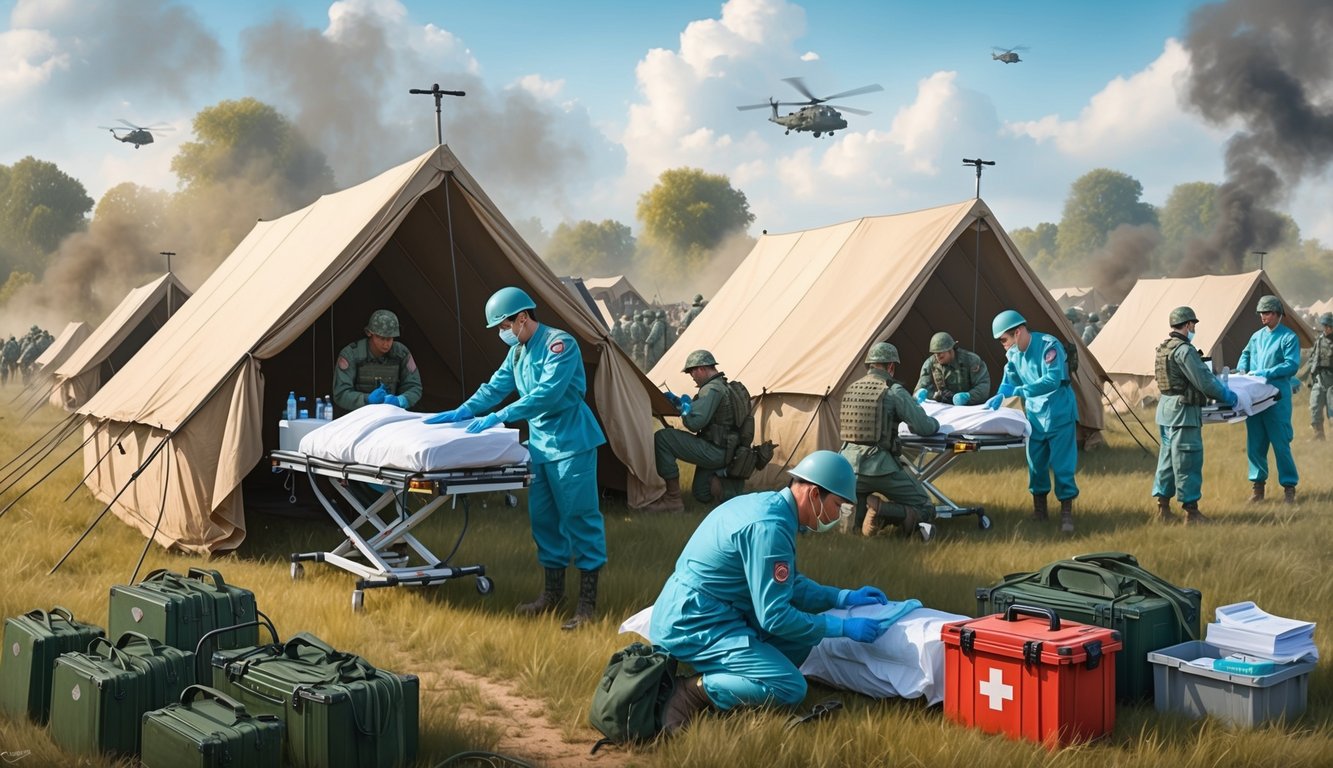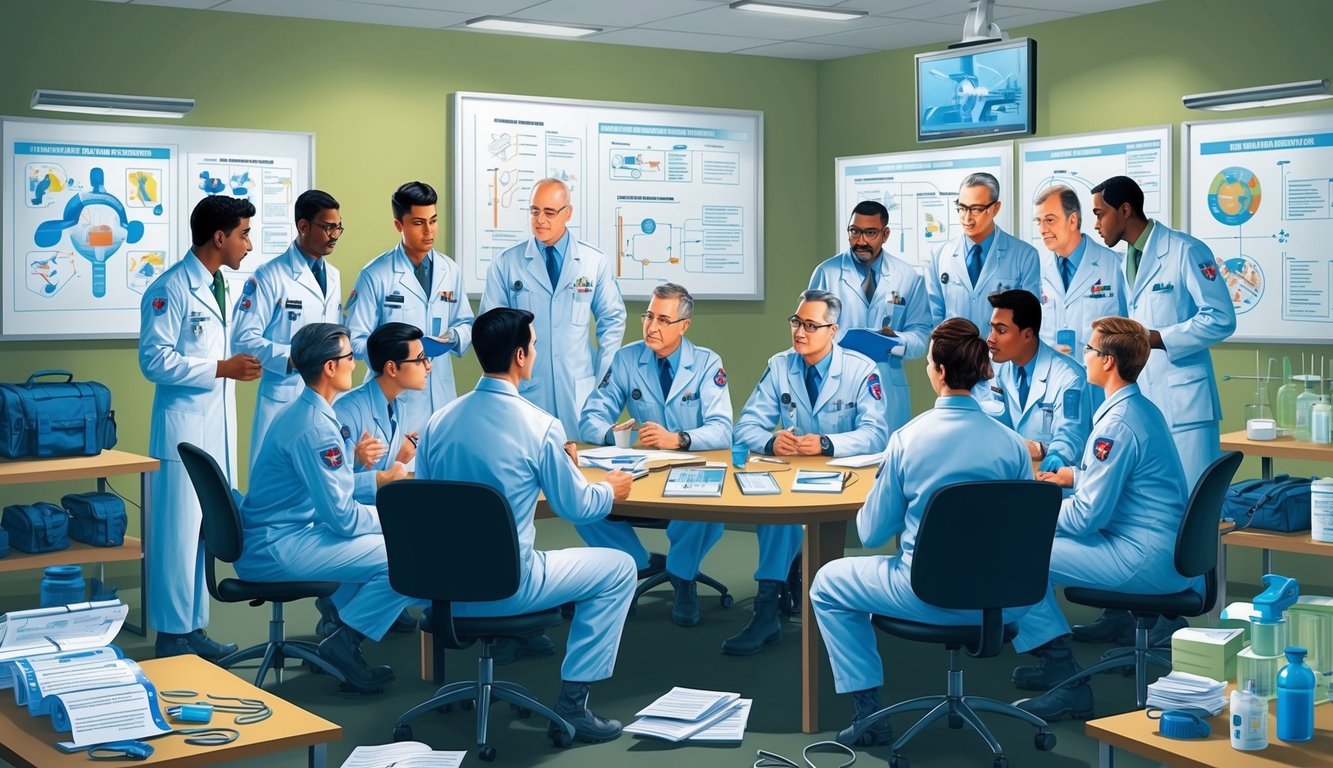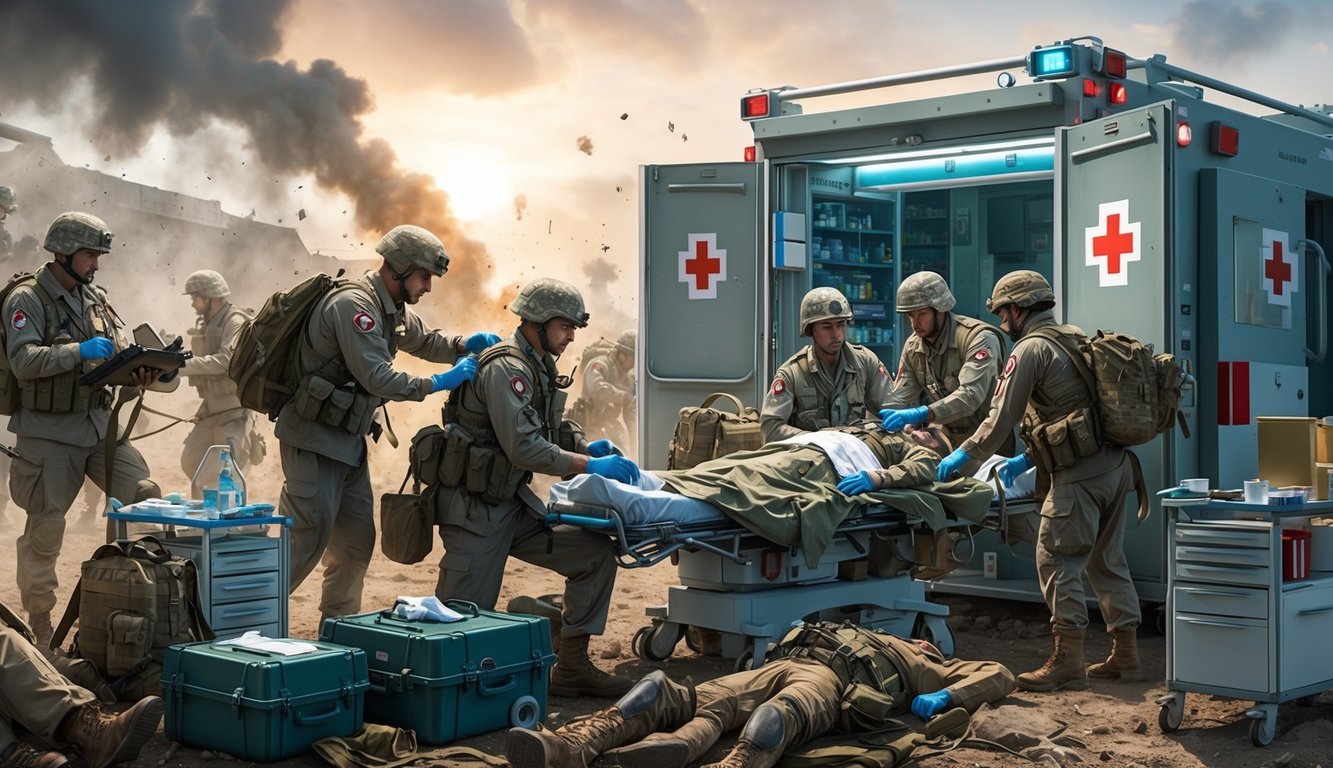Military medicine has undergone significant evolution over the centuries, propelled by the pressing need to preserve lives on the battlefield.
Spanning from ancient times to contemporary conflicts, medical advancements have arisen in the harsh realities of war, altering not only the treatment of soldiers but also enhancing civilian healthcare. Battlefield medicine has persistently expanded the frontiers of medical science, introducing innovative techniques and technologies that have rescued innumerable lives.
The progression of military medicine symbolizes a relentless struggle against time and adverse conditions.
You may be surprised to discover that numerous prevalent medical practices today, including triage systems and swift wound care, have their roots in battlefield needs.
These innovations have significantly boosted survival rates for wounded soldiers and transformed emergency medicine in civilian contexts.
As you delve into the history of military medicine, you will uncover a captivating saga of human creativity and empathy.
From the establishment of ambulance corps during the American Civil War to the innovations in blood transfusions during World War II, every conflict has contributed to medical advancements.
This evolution is ongoing, with groundbreaking research in fields like regenerative medicine and telesurgery poised to further enhance battlefield care.
Key Takeaways
- Battlefield medicine has consistently been a catalyst for medical innovation throughout history.
- A multitude of standard medical practices arose from military needs.
- Continuous research in military medicine is expanding the horizons of healthcare.
hnfong/public-crap
prompts/000-simple.prompt.human_bot.txt
Human: Write a short story about a robot that learns to appreciate human art.
Historical Evolution of Military Medicine
The journey of military medicine has been marked by extraordinary transformations.
Transitioning from basic battlefield treatments to advanced medical systems, it has significantly influenced the course of wars while saving countless lives.
Ancient Times and Middle Ages
In ancient civilizations, military medicine often revolved around religious and superstitious rites.
The Egyptian armies employed devoted physicians, while Greek forces had renowned healers like Hippocrates.
Roman legions pioneered organized medical care with field hospitals and designated surgeons, creating innovative instruments for arrow extraction and wound treatment.
During the Middle Ages, progress in military medicine lagged in Europe.
Most medical care for soldiers was provided by monastic orders.
Crusaders gradually imported Eastern medical knowledge, leading to improvements in battlefield care.
The Renaissance and Napoleonic Wars
The Renaissance marked a revival of military medical practices.
The French military surgeon Ambroise Paré innovated wound care by favoring ligatures over cauterization.
Throughout the Napoleonic Wars, more structured medical corps emerged.
Baron Dominique-Jean Larrey, Napoleon’s chief surgeon, introduced flying ambulances for the swift evacuation of injured soldiers.
Larrey also established triage systems, prioritizing treatment based on injury severity instead of rank, which significantly enhanced survival rates in combat zones.
The American Civil War and Jonathan Letterman
The American Civil War was a turning point for military medicine.
Jonathan Letterman, known as the “Father of Modern Battlefield Medicine,” transformed the medical framework of the Union Army.
Letterman implemented:
- A comprehensive ambulance corps
- Field hospitals positioned near combat zones
- A strategic triage system
His reforms sharply decreased mortality rates and laid the groundwork for contemporary military medical practices, influencing future conflicts for decades.
World Wars and the Surge of Medical Innovations
World War I accelerated advancements like the use of chemical weapons, spurring improvements in respiratory care and gas mask technology, while blood transfusions became commonplace, saving innumerable lives.
During World War II, notable developments included:
- Mass production of penicillin
- Advancements in surgical techniques
- Mobile army surgical hospitals (MASH units)
These innovations drastically reduced infection rates and enhanced survival prospects for injured soldiers, with significant strides in plastic surgery and rehabilitation as well.
Korean and Vietnam Wars: Advancing Forward
The Korean War built upon the advancements of WWII, refining MASH units and helicopter evacuation strategies.
Improvements in trauma care and blood preservation techniques were further established.
In Vietnam, rapid helicopter evacuations became standard practice, emphasizing the “golden hour” principle of prompt treatment within the first critical hour post-injury.
Additional advancements from this period included:
- Refined burn treatments
- Enhanced triage practices on the battlefield
- Greater knowledge of tropical diseases
These conflicts laid the foundational principles for modern combat medicine, stressing rapid response and specialized care that continues to develop.
Battlefield Medicine During Major Conflicts
Battlefield medicine has undergone profound transformations throughout major conflicts, reshaping trauma care and saving countless lives.
These advancements have influenced modern medical practices both in combat and civilian sectors.
Innovations from the Spanish-American War to World War II
During the Spanish-American War, X-rays were widely adopted in military medicine, allowing doctors to quickly locate bullets and shrapnel, thus enhancing surgical outcomes.
World War I brought significant shifts in battlefield medicine, such as the establishment of blood banks and transfusion protocols critical for addressing severe blood loss.
In World War II, the emergence of penicillin as a crucial antibiotic marked a significant breakthrough, allowing the treatment of infections that were previously deadly.
The introduction of mobile surgical hospitals ensured that expert care was accessible closer to the front lines, greatly improving survival rates.
Modern Military Medicine and Recent Conflicts
Recent conflicts have showcased remarkable advancements in trauma care.
Enhanced body armor and improved evacuation methods have led to reduced fatalities.
Combat medics are now equipped with advanced hemostatic agents to quickly address bleeding.
Telemedicine enables specialists to guide treatments remotely, with real-time ultrasounds being transmitted from the battlefield to medical facilities.
Some forward operating bases even utilize robotic surgical systems.
Mental health efforts have garnered attention, with combat stress teams embedded within units to offer immediate assistance.
Significant advancements in prosthetics have introduced mind-controlled limbs for some veterans.
Revolution in Medical Technologies and Practices
Military medicine has experienced remarkable growth, driven by the pressing needs of battlefield care.
These advancements have fundamentally changed the treatment of wounded soldiers, saving numerous lives.
Wound Care and Surgical Techniques
While you may have heard about antiseptics, they were initially developed on the battlefield.
During the Civil War, doctors noted that wounds exposed to certain conditions healed better, leading to the use of iodine as a disinfectant.
This innovation significantly lowered infection rates.
Anesthesia also saw substantial progress.
Ether and chloroform facilitated more intricate surgical procedures with less discomfort for patients.
The evolution of tourniquets has made them more efficient at stemming blood loss without inflicting tissue damage.
Blood transfusions emerged as a pivotal practice.
During World War II, the advent of blood banks and enhanced storage techniques considerably improved the survival rate of critically injured soldiers.
Triumph of Triage and Emergency Care
Triage systems revolutionized battlefield medicine.
While the concept is common in emergency rooms today, it was perfected during wartime.
Medics swiftly evaluated injuries, prioritizing those most likely to survive with immediate intervention.
Emergency trauma care made significant strides as well.
Strategies like damage control surgery focused on quickly stabilizing patients, addressing the most life-threatening issues first.
New tools were introduced too.
Portable ultrasound technologies allowed medics to quickly detect internal bleeding, while advanced bandages with clotting agents expedited wound management.
Improvement of Medical Logistics and Evacuation
Swift transportation of the wounded became paramount.
You’ve likely seen dramatic helicopter evacuations in films—this practice originated in Korea and was refined in Vietnam.
Mobile surgical units were positioned closer to battle zones, providing advanced care within the “golden hour” following an injury, substantially improving survival rates.
The logistics of medical supplies also saw enhancements.
Improved packaging and preservation methods ensured critical materials reached the front lines in usable condition, while refrigerated transport maintained the viability of blood and medications in harsh environments.
Public Health Contributions and Civilian Benefits
Military medicine has made noteworthy contributions to public health and civilian healthcare.
Discoveries made for military contexts have often been applied to everyday medical practice, benefiting the broader community.
Lessons Learned for Civilian Healthcare
You might be surprised by the significant influence of military medical advances in your everyday life.
Trauma care strategies honed in battle now save lives in emergency departments.
Additionally, triage systems designed for large-scale casualties enhance patient flow management in hospitals.
Military research has led to breakthroughs in the treatment of infectious diseases that affect civilians.
Vaccines and therapies for conditions like malaria and dengue fever often stem from military medical initiatives.
Moreover, disaster response strategies employed by civilian agencies frequently rely on the expertise developed within military medical frameworks for managing extensive health emergencies.
Veterans Health and Advancing Civilian Health Systems
Your local healthcare system is likely enhanced by the expertise of veteran medical professionals.
Many healthcare workers transition from military to civilian roles, bringing critical skills and insights.
Veterans’ health requirements have spurred advancements in prosthetics, rehabilitation approaches, and mental health therapies.
These enhancements now extend benefits to civilian patients experiencing similar challenges.
Military medicine’s emphasis on preventative care has also shaped public health initiatives.
You may have benefitted from health assessments or wellness programs inspired by military health strategies.
The utilization of electronic health records, now standard in civilian healthcare, originated within military medical systems, ensuring continuity of care for mobile service members.
Advances in Medical Personnel and Training
Military medicine has made remarkable strides in the capabilities of medical personnel and educational approaches, resulting in dramatically improved battlefield care and saving countless lives.
Combat Medics and Frontline Support
Combat medics now receive extensive training to deliver critical care in hostile environments.
These dedicated individuals are equipped with advanced medical kits and possess the skills to perform life-saving interventions under stress.
Their training encompasses wound management, airway maintenance, and medication administration.
Combat medics often don specialized equipment that allows for rapid access to medical supplies while maintaining mobility.
They are trained to collaborate in teams, coordinating evacuations and delivering care during transport.
Modern combat medics also leverage advanced technologies, including portable ultrasound tools and hemostatic agents, enabling them to diagnose and treat injuries effectively in challenging field conditions.
Educational Initiatives for Military Health Professionals
Military medical education has evolved, incorporating high-fidelity simulations and virtual reality training.
Military doctors and nurses engage in realistic, immersive exercises to practice advanced medical procedures before deployment.
Specialized curricula address battlefield-specific medical challenges, such as managing blast injuries or handling mass casualty situations.
Military health personnel also receive instruction in psychological first aid to support combat stress reactions.
Ongoing education programs ensure that military medical staff stay current with the latest advancements, often involving collaborations with civilian medical institutions to access new knowledge and techniques.
Research, Development, and the Future of Military Medicine

The field of military medicine is rapidly advancing through innovative research and technological breakthroughs aimed at enhancing care for service members in high-pressure environments.
Requirements-Driven Research and Collaboration
Military medical research typically arises from specific battlefield requirements.
Researchers collaborate closely with combat medics and field surgeons to pinpoint critical care gaps.
This partnership ensures that emerging technologies and treatments are practical and effective in real-world situations.
Joint ventures involving military and civilian institutions are gaining prominence.
These collaborations merge military insights with leading-edge civilian research, accelerating the creation of life-saving innovations.
Recent developments include enhanced hemostatic agents, portable diagnostic devices, and improved techniques for managing pain in battlefield conditions.
These advancements directly address the unique challenges faced by combat medics.
Infectious Diseases and Public Health Surveillance
Military personnel frequently encounter infectious diseases not typically present in civilian populations during operations.
Consequently, military medicine emphasizes research and surveillance related to infectious diseases.
There is a growing focus on creating rapid diagnostic tools for tropical diseases, enabling quick identification and treatment of illnesses that could jeopardize mission readiness.
Vector control strategies are advancing as well.
New repellents and protective gear are designed to minimize the risk of insect-borne diseases in deployment scenarios.
Global health surveillance networks, backed by military medical units, play a pivotal role in the early detection of potential pandemics, benefiting both military and civilian populations alike.
Prospects of Telemedicine and Remote Care
Significant strides have been made in telemedicine within military medicine.
Expect to see more advanced monitoring systems that allow medical experts to assist combat medics in real-time.
Wearable health monitoring devices are becoming increasingly sophisticated, tracking vital signs and alerting medics to developing health issues before they escalate.
Virtual reality training simulations are enhancing medical education for military personnel, equipping medics with preparedness for intense situations they may face in the field.
Innovations such as drone deliveries of medical supplies and AI-assisted triage systems are on the horizon, promising to extend the reach of medical care to remote and austere environments.
Influence and Legacy

Innovations stemming from military medicine have significantly influenced contemporary healthcare, evident in emergency response systems, disaster management, and even space exploration.
Impact on Modern Healthcare and Emergency Systems
Many life-saving techniques utilized in hospitals today originated on the battlefield.
Trauma centers owe a great deal to military field hospitals, which deliver rapid, coordinated care for severe injuries.
The military’s joint trauma system now guides civilian emergency responses, benefiting you when ambulances respond quickly and paramedics apply advanced first aid methods.
Triage protocols established for managing mass casualty scenarios originate from military medicine, enabling efficient patient prioritization in resource-limited situations.
Even everyday items, such as tourniquets and hemostatic agents, began as battlefield tools, now found in first aid kits everywhere.
Militarization of Space and Innovations in Extreme Environments
Space exploration presents unique medical challenges similar to combat scenarios.
Credit for advances in treating radiation exposure and bone density loss in zero gravity goes to military medicine.
Telemedicine’s roots in connecting battlefield medics to distant specialists have now evolved to support telehealth consultations from the comfort of home.
Military research on hypothermia treatment benefits mountain rescue teams, while strategies for managing heat-related illnesses support firefighters and athletes.
Portable medical devices, initially created for combat situations, are now utilized in emergency clinics and disaster zones around the globe.
Frequently Asked Questions

Military medicine has evolved immensely through major conflicts, addressing the urgent need for life-saving measures on the battlefield.
Innovations in trauma care, hygiene practices, and medical technologies have shaped modern combat healthcare.
What were the critical medical advancements during the Crimean War?
Florence Nightingale’s efforts transformed nursing and sanitary practices in hospitals.
Her focus on cleanliness drastically reduced mortality rates among wounded soldiers.
The introduction of chloroform as an anesthetic significantly improved surgical outcomes, facilitating more complex procedures on the battlefield with less suffering.
Can you describe the evolution of medical practices throughout World War I?
Broad utilization of blood transfusions became common, saving numerous lives.
Mobile X-ray units were developed to enable better diagnosis and treatment of injuries in field hospitals.
Triage systems were enhanced, allowing for prioritization of injuries based on severity, thereby improving resource allocation and survival rates in overwhelmed medical facilities.
What were the significant leaps in medical technology and care during World War II?
Penicillin emerged as a pivotal antibiotic, greatly decreasing deaths resulting from infections.
The wartime demand led to expedited production of penicillin.
Enhanced evacuation techniques, particularly helicopter utilization, enabled quicker transport of injured soldiers to medical facilities.
In what ways did the Civil War advance the field of medicine?
The Civil War popularized the use of anesthesia in surgeries, alleviating pain and improving patient survival rates.
The formation of organized ambulance corps facilitated systematic battlefield evacuations.
Additionally, advancements in prosthetics technology emerged from the high incidence of amputations during the war.
What are some notable facts about medical practices during the American Civil War?
Embalming methods were created to preserve bodies for transport back home, laying the groundwork for contemporary mortuary sciences.
The consistent use of chloroform and ether as anesthetics enabled longer, more intricate surgical procedures.
How did the challenges of warfare spur innovation in medical treatments and technology?
The surge of trauma cases fostered advancements in reconstructive surgical techniques.
Methods for plastic surgery and skin grafting were refined to treat severe burns and facial injuries.
Recognition of combat-induced psychological trauma led to preliminary studies of what we now call PTSD, laying the foundation for modern military psychiatry and psychology.

